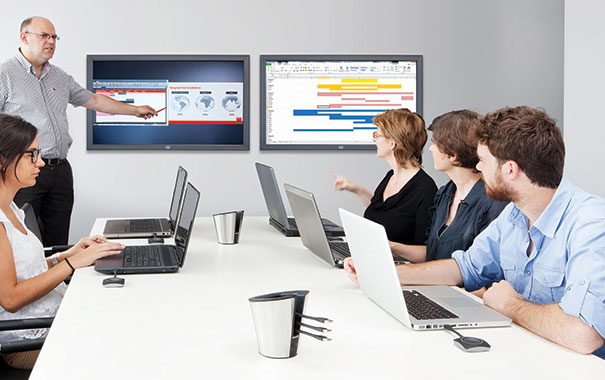
Wireless collaboration solutions, such as Barco’s ClickShare, eliminate the need for rack-mounted systems and communicate on a separate Wi-Fi network with the receiver acting as the wireless access point.
Communication and education strategies among health care teams, educators and other groups are changing with the need for group members to have less passive and more collaborative roles.
Technology designers, integrators and vendors recognize these needs and have responded with a wide range of alternatives for presenters and audiences.
Conference rooms, community outreach education rooms, boardrooms, team work areas and resident training areas in inpatient and outpatient facilities are rapidly evolving as recent developments provide exciting alternatives to the traditional health care audiovisual (AV) installation.
The evolving TV
In the past, a common setup for a conference room consisted of AV cables run from a floor box or wall plate to a ceiling-mounted projector.
This meant that lights had to be turned off, putting meeting attendees in the dark; the projector often was out of focus or not matched to the resolution of the computer; the audio came only from the presenter’s laptop; and the conference table was covered with cables.
As flat-panel TVs increased in size and decreased in price, many facilities turned to them as an alternative; but problems remained. A laptop using the TV as a monitor still required cables to connect to a floor box, wall plate or directly to the TV.
High-definition multimedia interface (HDMI) then became the preferred AV cable standard, providing high-definition (HD) video along with audio, but the short distance limitation of HDMI cables made them difficult to use in AV installations without bulky and expensive converters. At the same time, smartphones and tablets skyrocketed in popularity, which led to the bring-your-own-device (BYOD) movement. Users wanted to connect a multitude of devices for presentations in conference rooms and classrooms.
Many new products and technologies provide opportunities to improve and simplify AV installations. Television manufacturers have introduced models that integrate many features previously found in external devices such as Web browsers, Skype and Wi-Fi. Smart TVs typically run operating systems developed specifically for that purpose and rely on apps from manufacturer-specific app stores. For example, smart TVs from LG Electronics use webOS, an operating system derived from Linux, and run apps from LG SmartWorld.
Smart TVs generally have not used Microsoft Corp.’s Windows operating system. One option to display a PowerPoint presentation on a smart TV without a Windows PC connected is to use the “Broadcast Slide Show” or “Present Online” feature in PowerPoint to get a Web link, which then can be opened in a smart TV Web browser.
If Windows applications are frequently required, a facility could install an ultrasmall form factor Windows PC behind the TV, controlled by a wireless keyboard, mouse and presentation remote instead of using smart TV features. Intel Corp.’s recently announced Compute Stick is a dongle-sized Windows PC that plugs into a TV or projector through an HDMI input. At a low price, this product has the potential to be very popular in conference and classroom setups.
TVs have become popular alternatives to projector screens, although projector screens still have a size advantage over TVs. Screens should be as large as the space or budget allows, ensuring that text is readable from every part of the room. Projector screens likely will still be used until televisions with screens larger than 80 inches become affordable. Plasma TVs were desirable because of the superior viewing angle and contrast, but most manufacturers have stopped producing them.
The latest trend in TV screens is ultrahigh definition, often called 4K. The resolution is 3840 x 2160 as opposed to the 1920 x 1080 resolution that has become standard for large-screen HD television sets. Few devices are capable of this resolution today, but there may be applications for 4K in health care — for example, where picture archiving and communication system images are displayed in educational settings. From a cabling standpoint, 4K resolution uses high-speed HDMI cable and does not require a new type of cable.
Wireless transmission
While smart TVs provide powerful features, the need remains to connect external devices like laptops.
Some products have been introduced to wirelessly transmit a video signal, effectively acting as a wireless HDMI cable. Products such as Belkin International Inc.’s ScreenCast AV 4, Gefen LLC’s wireless for HDMI Extender SR, Kramer Electronics Ltd.’s KW-11 and IOGEAR’s wireless HD digital kit are able to transmit video wirelessly between devices. These products consist of a pair of devices — one that plugs into a transmitter and one that plugs into a receiver — and provide an inexpensive alternative to in-wall cabling and floor boxes. However, these products have disadvantages of their own.
For example, the transmitters for many of these solutions are bulky and not meant to be mobile. The transmitters require HDMI connections, which some devices like iPads do not have. Also, many of these products use proprietary wireless communications protocols on the 5 GHz radio frequency bands. Because the latest Wi-Fi standards 802.11n and 802.11ac also use the 5 GHz radio frequency bands, these products could interfere with the building’s wireless network. This is only one approach to sharing AV content wirelessly, and alternative approaches are used in other products.
Apple Inc.’s AirPlay feature allows the real-time video and audio of Wi-Fi-connected Apple devices, including the iPhone and iPad, to be mirrored to a television or projector via the Apple TV, an inexpensive device small enough to mount behind a TV. While AirPlay is an Apple proprietary protocol, third-party software may be purchased to add flexibility.
Software such as AirMyPC and Squirrels’ AirParrot allow a non-Apple device such as a staff member’s Windows laptop to function as an AirPlay transmitter. Software such as App Dynamic’s AirServer and Squirrels’ Reflector allows a Windows PC to function as an AirPlay receiver. Because technologies like AirPlay run on the wireless network, the network will need the capacity and throughput to support this traffic. The main drawback of using AirPlay is its limited support of non-Apple devices. This makes it less than ideal for BYOD environments.
Google Inc.’s Chromecast packs impressive features in a very small and inexpensive dongle. It plugs into a TV or projector through an HDMI input and connects to the Wi-Fi network. It can be powered from a universal serial bus (USB) port on the television. Chromecast can mirror a Chrome Internet browser tab from a PC or Mac. It also can mirror the entire screen, although this currently is an experimental feature. Computers need the Chrome browser and Google Cast browser extension installed to connect to Chromecast. Android phones can connect to Chromecast via the Chromecast app. The mirrored video has some delay and choppiness, but the quality may be sufficient for a conference room where mostly PowerPoint slides and spreadsheets would be displayed. At a very modest price, a health care facility easily can add Chromecast to an existing conference room to determine if it meets the facility’s needs.
In contrast to AirPlay and Chromecast, where the devices connect to a common wireless network, Miracast is a wireless display standard that uses a Wi-Fi Direct connection in which two devices communicate directly. Microsoft Windows 8.1 and Android 4.2 added Miracast as a built-in feature. Miracast also is built into some of the latest smart TV models.
For displays without Miracast built in, a Miracast dongle can be used. Microsoft’s newly released wireless display adapter is a Miracast dongle with a form factor similar to that of Chromecast. Miracast certification is performed by the Wi-Fi Alliance. Some manufacturers use their own standards based on Miracast. For example, Samsung markets a feature called AllShare Cast built into the latest Samsung smart TVs, tablets and phones. While all Miracast devices should be compatible, interoperability issues have been reported.
Using Wi-Fi Direct has some advantages. It keeps traffic off the building’s existing wireless network. It also does not require the devices to be connected to the building’s network, which may be convenient for guests such as visiting vendors. However, information technology departments will need to give their input to ensure that Wi-Fi Direct is acceptable. Some organizations do not allow ad hoc networks because of network security concerns. Also the Wi-Fi Direct network may negatively impact the building’s existing wireless network if it uses the same channel as a nearby wireless access point. Another disadvantage of Wi-Fi Direct is that some devices cannot be associated to multiple wireless networks at the same time. A device may not be able to access the network and Internet through the building’s wireless network while mirroring its display with Miracast, a promising technology that is not yet widely supported by many devices.
Teleconferencing systems
Video teleconferencing (VTC) systems have been used in health care settings for some time.
The Skype capability of smart TVs could find many applications in health care, such as distance learning, specialist consultations and telemedicine. Smart TVs with Skype typically require an external camera and microphone connected via USB, although some models have included built-in cameras. Skype has become a viable alternative to traditional VTC systems, which can be expensive and require professional installation. The more elaborate room-based VTC solutions from vendors like Cisco Systems Inc., Polycom or Logitech’s Lifesize division still need to be used for applications requiring high-quality video, multiple cameras and shared content.
If health information covered under the HIPAA law will be exchanged through a VTC system, the legal ramifications need to be considered by the health care provider. There are many gray areas when it comes to telemedicine, HIPAA and VTC.
Regardless of the complexity of the VTC system, new cloud-based services provide exciting enhancements to video teleconferencing. One such service is Blue Jeans, a cloud service allowing multiparty video teleconferencing across many platforms, ranging from traditional room-based VTC systems to users on desktop computers, laptops and mobile devices.
In the past, a facility would need to purchase a hardware unit called a multipoint control unit (MCU) to allow multiparty video teleconferencing. These MCUs had limited interoperability between vendors and communications standards. Cloud-based video teleconference bridging services make existing systems more powerful and add VTC functionality to nearly any device by allowing cross-platform interoperability.
Developments in the commercial AV market also provide capabilities that previously were impractical or impossible. One major development is the rise of wireless collaboration systems such as Christie Digital Systems USA Inc.’s Christie Brio, Barco’s ClickShare, Kramer Electronics Ltd.’s VIA Collage/VIA Connect PRO and Crestron Electronics Inc.’s AM-100. In the past, switching between several devices often would require rack-mounted equipment or manually unplugging and plugging devices. Having multiple people simultaneously connect their laptops at a conference table was rare because of the infrastructure requirements. Wireless collaboration systems make this a reality.
For example, Kramer’s VIA Connect PRO allows multiple meeting attendees to share their screens wirelessly with up to four screens shown on a single display. A PC, Mac or smartphone with the free VIA app installed can connect, making this a viable solution in BYOD environments. Attendees also can collaborate by making annotations, sharing files and chatting. The VIA Connect PRO is small enough to mount behind a display. Christie Brio Enterprise and other solutions allow attendees in different geographic locations to collaborate.
Some of the wireless collaboration solutions, such as Barco ClickShare and Christie Brio Team, communicate on a separate Wi-Fi network with the receiver acting as the wireless access point. This has similar advantages and disadvantages to Miracast’s Wi-Fi Direct approach. Other devices like the Christie Brio Enterprise, Crestron AM-100 and Kramer VIA Collage/VIA Connect PRO use the existing wired and wireless network.
Health facilities professionals would need to determine if a proposed solution is acceptable. Because wireless collaboration systems are designed for commercial environments, information technology departments may find them preferable to consumer products like Apple TV. Wireless collaboration solutions are expensive compared with consumer products that simply mirror a single display, but they offer capabilities that have never before been possible in conference room and classroom settings.
AV outlook
Many of the current struggles with AV will become history, thanks to the latest advances in AV technology.
Whether an AV setup is as simple as a wall-mounted TV or includes cutting-edge, multiscreen video teleconferencing and wireless collaboration systems, health care facilities have solutions that are relatively inexpensive and easy to deploy.
Health facilities professionals will see even more features and functionality as smart TVs and wireless AV connections become not only common, but expected in conference room, training and education areas. HFM
Robert Hume, PE, CCNA, is a project manager at GBA, a health care technology consulting firm based in Franklin, Tenn. He can be reached at Robert.Hume@gbainc.com.
Tips for health care audiovisual projects
Audiovisual (AV) installations both big and small can result in missteps, headaches and disappointment without proper planning. Here are some tips to help a health facilities professional’s next AV project go smoothly.
• AV infrastructure must be planned early for construction projects, but the purchased systems must reflect current technology trends after completion.
• Consider recessed boxes for power and AV connections behind televisions. Products like Peerless-AV’s Model IM760P and Milestone AV Technologies’ Chief PAC501B include an articulating mount integrated with a recessed box. This allows for clean, low-profile installations.
• Pre-terminated AV cables are often too large to be pulled through conduit. Consider products like RapidRun with removable and interchangeable connectors.
• Video graphics array (VGA) outputs are being phased out in favor of digital outputs like high-definition multimedia interface (HDMI). This is driven in part by the Advanced Access Content System Licensing Administrator LLC, an organization that pushes for digital copy protection.
• Ensure that HDMI products support high-bandwidth digital copy protection (HDCP) by outlining the requirement in a request for proposal and reviewing product submittals.
• The variety of apps available on smart televisions is currently quite limited. Do not assume that a smart TV will have the same capabilities as a PC or tablet.
• When selecting a television, look for universal serial bus ports to power external devices like Google Inc.’s Chromecast and Microsoft Corp.’s wireless display adaptor.
• Devices such as Apple Inc.’s Apple TV can connect to a network through a wired or wireless connection. Wired network connections should be used wherever possible because the unnecessarily high volume of traffic could bog down the Wi-Fi network.
• Even if a wireless AV product does not use Wi-Fi, it likely uses the same unlicensed radio frequency bands as Wi-Fi (2.4 and 5 GHz). Information technology, biomedical and facilities departments will need to work in tandem to prevent wireless AV devices from interfering with existing systems. This goes beyond Wi-Fi to include medical telemetry, patient monitoring, wireless refrigerator temperature monitoring systems, cordless phones and Bluetooth devices.




